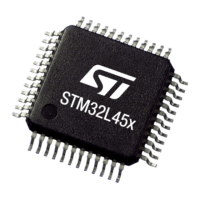SM CODE SPI_SM_4
Detailed implementation
This method aims to protect the communication between SPI peripheral and his external
counterpart.
Refer to UART_SM_3 description for detailed information.
Error reporting Refer to UART_SM_3
Fault detection time Refer to UART_SM_3
Addressed fault model Refer to UART_SM_3
Dependency on Device configuration Refer to UART_SM_3
Initialization Refer to UART_SM_3
Periodicity Refer to UART_SM_3
Test for the diagnostic Refer to UART_SM_3
Multiple-fault protection Refer to UART_SM_3
Recommendations and known limitations
Refer to UART_SM_3 for further notice.
It is assumed that the remote SPI counterpart has an equivalent capability of performing the
checks described.
3.6.37 Serial audio interface (SAI)
Table 132. SAI_SM_0
SM CODE SAI_SM_0
Description Periodic read-back of SAI configuration registers
Ownership End user
Detailed implementation
This method must be applied to SAI configuration registers.
Detailed information on the implementation of this method can be found in
Section 3.6.14 Extended interrupt and events controller (EXTI).
Error reporting Refer to NVIC_SM_0
Fault detection time Refer to NVIC_SM_0
Addressed fault model Refer to NVIC_SM_0
Dependency on Device configuration Refer to NVIC_SM_0
Initialization Refer to NVIC_SM_0
Periodicity Refer to NVIC_SM_0
Test for the diagnostic Refer to NVIC_SM_0
Multiple-fault protection Refer to NVIC_SM_0
Recommendations and known limitations Refer to NVIC_SM_0
Table 133. SAI_SM_1
SM CODE SAI_SM_1
Description SAI output loopback scheme
Ownership End user
Detailed implementation
This method uses a loopback scheme to detect permanent and transient faults on the output
channel used for serial audio frame generation. It is implemented by connecting the second
serial audio interface as input for primary output generation. Application software is able
therefore to identify wrong or missing audio frame generation.
Error reporting Depends on implementation
UM2305
Hardware and software diagnostics
UM2305 - Rev 10
page 74/110

